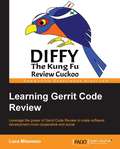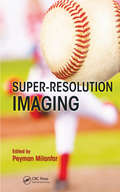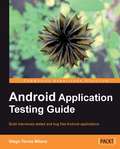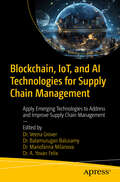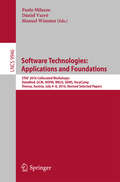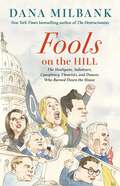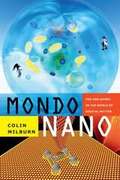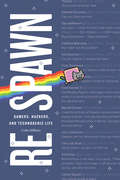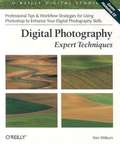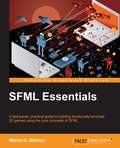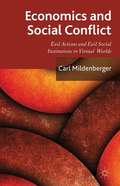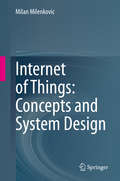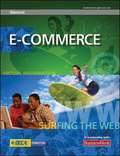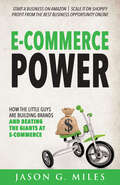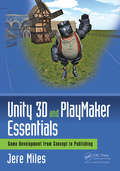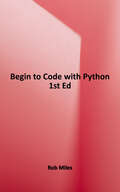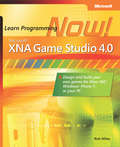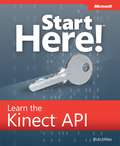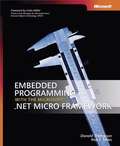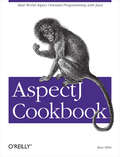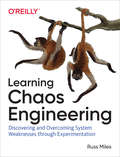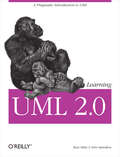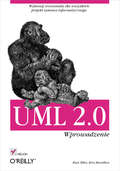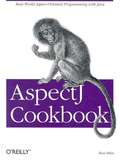- Table View
- List View
Learning Gerrit Code Review
by Luca MilanesioA practical and a fast paced guide that gives you all the information you need to make software development more cooperative and social. This book is written for team leaders and developers who wish to reap the benefit of Gerrit and improve collaboration by introducing code review practices.
Super-Resolution Imaging (Digital Imaging and Computer Vision)
by Peyman MilanfarWith the exponential increase in computing power and broad proliferation of digital cameras, super-resolution imaging is poised to become the next "killer app." The growing interest in this technology has manifested itself in an explosion of literature on the subject. Super-Resolution Imaging consolidates key recent research contributions from eminent scholars and practitioners in this area and serves as a starting point for exploration into the state of the art in the field. It describes the latest in both theoretical and practical aspects of direct relevance to academia and industry, providing a base of understanding for future progress. Features downloadable tools to supplement material found in the book Recent advances in camera sensor technology have led to an increasingly larger number of pixels being crammed into ever-smaller spaces. This has resulted in an overall decline in the visual quality of recorded content, necessitating improvement of images through the use of post-processing. Providing a snapshot of the cutting edge in super-resolution imaging, this book focuses on methods and techniques to improve images and video beyond the capabilities of the sensors that acquired them. It covers: History and future directions of super-resolution imaging Locally adaptive processing methods versus globally optimal methods Modern techniques for motion estimation How to integrate robustness Bayesian statistical approaches Learning-based methods Applications in remote sensing and medicine Practical implementations and commercial products based on super-resolution The book concludes by concentrating on multidisciplinary applications of super-resolution for a variety of fields. It covers a wide range of super-resolution imaging implementation techniques, including variational, feature-based, multi-channel, learning-based, locally adaptive, and nonparametric methods. This versatile book can be used as the basis for short courses for engineers and scientists, or as part of graduate-level courses in image processing.
Android Application Testing Guide
by Diego Torres MilanoAndroid Application Testing Guide is a highly detailed book which gives step-by-step examples for a great variety of real-world cases, providing professional guidelines and recommendations that will be extremely valuable for optimizing your development time and resources. In the chapters you will find an introduction to specific testing techniques, and tools for specific situations.If you are an Android developer looking to test your applications or optimize your application development process, then this book is for you. No previous experience in application testing is required.
Blockchain, IoT, and AI Technologies for Supply Chain Management: Apply Emerging Technologies to Address and Improve Supply Chain Management
by Mariofanna Milanova Veena Grover B. Balamurugan Balusamy A. Yovan FelixExamine the synergistic possibilities of combining blockchain, IoT, and AI technologies in supply chain management. This book will address the difficulties and possibilities of integrating these technologies and offer helpful implementation advice. The current state of supply chain management involves several challenges, including lack of transparency, limited visibility into product movements, inefficient inventory management, and difficulty in tracking and tracing products. Blockchain, IoT, and AI can potentially address some of these challenges and improve supply chain management. To help illustrate this, case studies and actual instances of businesses implementing or experimenting with blockchain, IoT, and AI technology in their supply chains are included in the book. You’ll review helpful advice on implementation and highlight successful deployments, lessons learned, and the impact of these technologies on supply chain visibility, agility, sustainability, and customer experience. This book further elaborates the fundamental concepts of AI and ML algorithms and demonstrates how AI can process enormous volumes of supply chain data to produce actionable insights, improve inventory control, forecast demand, and increase forecasting precision. This collective work will serve as a comprehensive guide for supply chain professionals, researchers, and technology enthusiasts interested in understanding the potential of blockchain, IoT, and AI technologies in revolutionizing supply chain management practices. What You Will Learn Discuss the evolving landscape of technology, potential advancements, and how Blockchain, IoT, and AI can shape the future of supply chainsGain Insight into upcoming developments and prepare for changing dynamics of the industryUnderstand intricate details of blockchain, IoT, and AI Technologies in real-life scenarios Who Is This Book For Industry Professionals working in the domain of supply chain management who would be interested in understanding how these technologies can enhance efficiency, transparency, and optimization in their supply chains.
Software Technologies: Applications and Foundations
by Paolo Milazzo Dániel Varró Manuel WimmerThis book contains the thoroughly refereed technical papers presented in six workshops collocated with the International Conference on Software Technologies: Applications and Foundations, STAF 2016, held in Vienna, Austria, in July 2016. The six workshops whose papers are included in this volume are: DataMod, GCM, HOFM, MELO, SEMS, and VeryComp. The 33 full and 3 short papers presented were carefully reviewed and selected from 53 submissions. They focus on practical and foundational advances in software technology covering a wide range of aspects including formal foundations of software technology, testing and formal analysis, graph transformations and model transformations, model driven engineering, and tools.
Fools on the Hill: The Hooligans, Saboteurs, Conspiracy Theorists, and Dunces Who Burned Down the House
by Dana MilbankFrom the halls of Congress, New York Times bestselling author Dana Milbank exposes the chaotic, incompetent and dysfunctional state of the current Republican House—a confederacy of dunces, united by paranoia and conspiracy theories, blundering from one self-inflicted crisis to the next. When Republicans took control of the House in the 2022 midterm elections with a historically slim majority, mayhem began immediately. &“Failed completely.&” &“Can&’t govern.&” &“Broken.&” &“Lunatics.&” &“Embarrassing.&” &“Bunch of idiots.&” And that&’s how House Republicans described themselves. Take it from Marjorie Taylor Greene, who said in May 2024 that &“many Americans in general are sick and tired and fed up with a feckless, useless Republican Party, a conference that does nothing.&” This is the House of George Santos and Jim Jordan, of Lauren Boebert and Matt Gaetz. They investigated space aliens and Hunter Biden&’s art dealer. They punched and they groped. They championed Confederates and insurrectionists—while disparaging the military and sabotaging the economy. They tied up the House so often with far-right fantasies that they produced what was arguably the least effective session of Congress in history. Dana Milbank, widely-read Washington Post columnist, spent a year reporting from inside the Capitol, watching the circus from the front row. The result, Fools on the Hill, is simultaneously horrifying and laugh-out-loud funny. Sadly, it is all true.
Mondo Nano: Fun and Games in the World of Digital Matter
by Colin MilburnIn Mondo Nano Colin Milburn takes his readers on a playful expedition through the emerging landscape of nanotechnology, offering a light-hearted yet critical account of our high-tech world of fun and games. This expedition ventures into discussions of the first nanocars, the popular video games Second Life, Crysis, and BioShock, international nanosoccer tournaments, and utopian nano cities. Along the way, Milburn shows how the methods, dispositions, and goals of nanotechnology research converge with video game culture. With an emphasis on play, scientists and gamers alike are building a new world atom by atom, transforming scientific speculations and video game fantasies into reality. Milburn suggests that the closing of the gap between bits and atoms entices scientists, geeks, and gamers to dream of a completely programmable future. Welcome to the wild world of Mondo Nano.
Respawn: Gamers, Hackers, and Technogenic Life (Experimental Futures)
by Colin MilburnIn Respawn Colin Milburn examines the connections between video games, hacking, and science fiction that galvanize technological activism and technological communities. Discussing a wide range of games, from Portal and Final Fantasy VII to Super Mario Sunshine and Shadow of the Colossus, Milburn illustrates how they impact the lives of gamers and non-gamers alike. They also serve as resources for critique, resistance, and insurgency, offering a space for players and hacktivist groups such as Anonymous to challenge obstinate systems and experiment with alternative futures. Providing an essential walkthrough guide to our digital culture and its high-tech controversies, Milburn shows how games and playable media spawn new modes of engagement in a computerized world.
Digital Photography: Expert Techniques
by Ken MilburnThis absorbing book, by professional photographer and author Ken Milburn, offers a ton of expert advice to those who are ready to move to the next level with digital photography. Rather than a general discussion of photography principles, Digital Photography: Expert Techniques focuses on workflow: time-tested, step-by-step procedures based on hard-nosed experience by and for genuine practitioners of the art. The book's conversational tone presents detailed information about what to look for in today's affordable high-end digicams, how to use simple techniques and equipment to shoot breathtaking shots, instructions on shooting great panoramas, dos-and-don'ts for creating better Photoshop masks, and professional digital darkroom techniques for everything from knockouts to restoration to transforming your photos into watercolors. It even shows you how to get your most prized photographs printed and ready for exhibition. Contents include: Understanding your digital camera from the inside out. Creating effects with the camera: making panoramas, high-resolution matrixes, infrared photos, and more. General composition and managing your workflow. Using the digital darkroom and Photoshop CS to make your images professional caliber. Understanding the power of Photoshop CS selections and masks. Using special effects to save what's good, and get rid of the bad and the ugly. Creating fictitious photos: bend and wrap images to fit an object, insert a more interesting skyscrape, and more. Professional color and tonal management Creating portfolios and presenting your images on the Web. Digital Photography: Expert Techniques is in four-color front to back, allowing you to see each step in the Digital Photographer's workflow, including the steps in-between. Serious photographers, including professionals, who want to take advantage of the unique creative powers available through digital photography and digital image processing will find this problem-solving book invaluable.
SFML Essentials
by Milcho G. MilchevIf you are an enthusiast who is not new to the field of game development but want to exercise the countless features of SFML and build 2D games with minimal effort, this is the book for you.
Economics and Social Conflict: Evil Actions and Evil Social Institutions in Virtual Worlds
by Carl D. MildenbergerThis book brings to life the classic thought experiment of a natural state. Provides data on the economic aspects of social conflict of 400.000 people living in a virtual anarchy; showing evil actions and rules exist from an economic perspective. Non-instrumental violence has economic effects and inciting people to fight are not overcome in time.
Internet of Things: Concepts and System Design
by Milan MilenkovicThis comprehensive overview of IoT systems architecture includes in-depth treatment of all key components: edge, communications, cloud, data processing, security, management, and uses. Internet of Things: Concepts and System Design provides a reference and foundation for students and practitioners that they can build upon to design IoT systems and to understand how the specific parts they are working on fit into and interact with the rest of the system. This is especially important since IoT is a multidisciplinary area that requires diverse skills and knowledge including: sensors, embedded systems, real-time systems, control systems, communications, protocols, Internet, cloud computing, large-scale distributed processing and storage systems, AI and ML, (preferably) coupled with domain experience in the area where it is to be applied, such as building or manufacturing automation. Written in a reader-minded approach that starts by describing the problem (why should I care?), placing it in context (what does this do and where/how does it fit in the great scheme of things?) and then describing salient features of solutions (how does it work?), this book covers the existing body of knowledge and design practices, but also offers the author’s insights and articulation of common attributes and salient features of solutions such as IoT information modeling and platform characteristics.
E-Commerce
by James E. Miles Chip DolceE-Commerce doesn't simply show students how to design Web sites - this flexible and reader-friendly program takes students on a comprehensive tour of every facet of electronic commerce. They'll learn about Web success stories; they'll work through hands-on e-commerce projects; and they'll discover how to use their skills in reading, writing, science, and math to resolve e-commerce questions.
E-Commerce Power: How the Little Guys Are Building Brands and Beating the Giants at E-Commerce
by Jason G. MilesAn online marketing expert shares practical steps for starting and scaling your e-commerce brand—plus interviews with successful online entrepreneurs.In the age of Amazon, e-commerce is the name of the game. And over the past few years, the shift to online shopping has radically accelerated. If you don’t have an e-commerce business yet, it’s time to start one! If you already have one, it’s time to scale up. E-Commerce Power teaches you how to harness the power of the niche brand model. It is filled with useful knowledge and practical tips such as proven online marketing methods, management and goal-setting techniques, and advice on developing new products from brainstorm to launch and beyond. Plus informative interviews with entrepreneurs, including:Mike Brown, Death Wish Coffee Zac Martin, Yellow Hammer ToolsAlex Shirley-Smith, TentsileLisa and Jared Madsen, Madsen Cycles Ashley Turner, Farmbox Direct Cinnamon Miles, Pixie FaireDaniel Leake, Catfish SumoAtulya Bingham, The Mud Home
Unity 3D and PlayMaker Essentials: Game Development from Concept to Publishing (Focal Press Game Design Workshops)
by Jere MilesIn introducing new students to video game development, there are two crucial components to consider: design and implementation. Unity 3D and PlayMaker Essentials: Game Development from Concept to Publishing provides theoretical background on topics such as characters, stories, level design, interface design, audio, game mechanics, and tools and skills needed. Each chapter focuses on a specific topic, with topics building upon each other so that by the end of the book you will have looked into all the subjects relevant to creating your own game. The book transitions from discussion to demonstrations of how to implement techniques and concepts into practice by using Unity3D and PlayMaker. Download boxes are included throughout the book where you can get the version of the game project under discussion or other content to add to the project, as well as any supplementary video tutorials that have been developed. Addressing both theoretical and practical aspects, Unity 3D and PlayMaker Essentials enables you to understand how to create a game by having you make a game. By gradually completing your own design document through the course of the book, you will become familiar with core design principles while learning the practical skills needed to bring your unique game to life.
Begin to Code with Python
by Rob MilesStart writing software that solves real problems, even if you have absolutely no programming experience! This friendly, easy, full-color book puts you in total control of your own learning, empowering you to build unique and useful programs. Microsoft has completely reinvented the beginning programmer’s tutorial, reflecting deep research into how today’s beginners learn, and why other books fall short. Begin to Code with Python is packed with innovations, from its “Snaps” prebuilt operations to its “Make Something Happen” projects. Whether you’re a total beginner or you’ve tried before, this guide will put the power, excitement, and fun of programming where it belongs: in your hands! <p><p>Easy, friendly, and you’re in control! Learn how to... <p>•Get, install, and use powerful free tools to create modern Python programs <p>•Learn key concepts from 170 sample programs, and use them to jumpstart your own <p>•Discover exactly what happens when a program runs <p>•Approach program development with a professional perspective <p>•Learn the core elements of the Python language <p>•Build more complex software with classes, methods, and objects <p>•Organize programs so they’re easy to build and improve <p>•Capture and respond to user input <p>•Store and manipulate many types of real-world data <p>•Define custom data types to solve specific problems <p>•Create interactive games that are fun to play <p>•Build modern web and cloud-based applications <p>•Use pre-built libraries to quickly create powerful software <p><p>About This Book <p>•For absolute beginners who’ve never written a line of code <p>•For anyone who’s been frustrated with other beginning programming books or courses <p>•For people who’ve started out with other languages and now want to learn Python <p>•Works with Windows PC, Apple Mac, Linux PC, or Raspberry Pi <p>•Includes mapping of MTA exam objectives that are covered in this book, as well as an appendix with further explanation of some of the topics on the exam
Microsoft® XNA® Game Studio 4.0: Learn Programming Now!
by Rob MilesNow you can build your own games for your Xbox 360®, Windows® Phone 7, or Windows-based PC--as you learn the underlying concepts for computer programming. Use this hands-on guide to dive straight into your first project--adding new tools and tricks to your arsenal as you go. No experience required! Learn XNA and C# fundamentals--and increase the challenge with each chapter Write code to create and control game behavior Build your game's display--from graphics and text to lighting and 3-D effects Capture and cue sounds Process input from keyboards and gamepads Create features for one or multiple players Tweak existing games--and invent totally new ones
Start Here!™ Learn the Kinect™ API
by Rob MilesReady to learn Kinect programming? Start Here!TM Learn the fundamentals of programming with the KinectTM API--and begin building apps that use motion tracking, voice recognition, and more. If you have experience programming with C#--simply start here! This book introduces must-know concepts and techniques through easy-to-follow explanations, examples, and exercises. Here's where you start learning Kinect Build an application to display Kinect video on your PC Have Kinect take photographs when it detects movement Draw on a computer screen by moving your finger in the air Track your body gestures and use them to control a program Make a program that understands your speech and talks back to you Play a part in your own augmented reality game Create an "air piano" using Kinect with a MIDI device
Embedded Programming with the Microsoft® .NET Micro Framework
by Rob Miles Donald ThompsonGet the information you need for programming applications in the rich, managed-code environment of the Microsoft .NET Micro Framework. You'll learn how to extend your experience with the .NET Framework and Microsoft Visual C# through real-world examples, expert insights, and code samples--and efficiently build robust applications for the smallest devices. Discover how to: Use an object-oriented approach for programming embedded devices Create input and output port objects Develop detailed text and graphical displays that support complex user interactions Add Windows SideShow functionality into your application Implement functionality from existing applications to embedded applications Bind physical hardware events to Windows Presentation Foundation elements Establish embedded-network connections using TCP/IP Use emulation techniques for rapid-prototyping, experimentation, testing, and debugging Optimize performance of resource-constrained devices PLUS--Get code samples in Visual C# on the Web
AspectJ Cookbook
by Russ MilesWhen Object Oriented programming (OO) first appeared, it was a revelation. OO gave developers the ability to create software that was more flexible and robust, but as time went on and applications became more sophisticated, too, certain areas of "traditional" OO architectures were found wanting. Aspect-oriented programming (AOP) addresses those issues by extending the OO approach even further. Many developers are interested in AOP--especially in AspectJ, the open source extension of the Java programming language that explicitly supports the AOP approach. Yet, although AspectJ is included with Eclipse, the increasingly popular open source IDE for Java, finding a practical and non-theoretical way to learn this language and other AOP tools and techniques has been a real problem. Until now. The AspectJ Cookbook offers a hands-on solution--in fact, several--with a wide variety of code recipes for solving day-to-day design and coding problems using AOP's unique approach. AOP allows the global properties of a program to determine how it's compiled into an executable program. Before AOP, important program design decisions were difficult to capture in actual code. Instead, the implementation of those design decisions--known as "aspects"--were scattered throughout, resulting in "tangled" code that was hard to develop and maintain. AOP has been compared to the manufacturing of cloth, in which threads are automatically interwoven. Without AOP, programmers must stitch the threads by hand. The AspectJ Cookbook shows readers why, and how, common Java development problems can be solved by using AOP techniques. With our popular problem-solution-discussion format, the book presents real world examples to demonstrate that AOP is more than just a concept; it's a development process that will benefit users in an immediate and visible manner. If you're interested in how AOP is changing the way software is developed, and how you can use AspectJ to make code more modular, easier to develop, maintain, evolve and deploy, this is the book that really delivers.
Learning Chaos Engineering: Discovering and Overcoming System Weaknesses Through Experimentation
by Russ MilesMost companies work hard to avoid costly failures, but in complex systems a better approach is to embrace and learn from them. Through chaos engineering, you can proactively hunt for evidence of system weaknesses before they trigger a crisis. This practical book shows software developers and system administrators how to plan and run successful chaos engineering experiments.System weaknesses go beyond your infrastructure, platforms, and applications to include policies, practices, playbooks, and people. Author Russ Miles explains why, when, and how to test systems, processes, and team responses using simulated failures on Game Days. You’ll also learn how to work toward continuous chaos through automation with features you can share across your team and organization.Learn to think like a chaos engineerBuild a hypothesis backlog to determine what could go wrong in your systemDevelop your hypotheses into chaos engineering experiment Game DaysWrite, run, and learn from automated chaos experiments using the open source Chaos ToolkitTurn chaos experiments into tests to confirm that you’ve overcome the weaknesses you discoveredObserve and control your automated chaos experiments while they are running
Learning UML 2.0
by Russ Miles Kim Hamilton"Since its original introduction in 1997, the Unified Modeling Language has revolutionized software development. Every integrated software development environment in the world--open-source, standards-based, and proprietary--now supports UML and, more importantly, the model-driven approach to software development. This makes learning the newest UML standard, UML 2.0, critical for all software developers--and there isn't a better choice than this clear, step-by-step guide to learning the language." --Richard Mark Soley, Chairman and CEO, OMG If you're like most software developers, you're building systems that are increasingly complex. Whether you're creating a desktop application or an enterprise system, complexity is the big hairy monster you must manage.The Unified Modeling Language (UML) helps you manage this complexity. Whether you're looking to use UML as a blueprint language, a sketch tool, or as a programming language, this book will give you the need-to-know information on how to apply UML to your project. While there are plenty of books available that describe UML, Learning UML 2.0 will show you how to use it. Topics covered include:Capturing your system's requirements in your model to help you ensure that your designs meet your users' needsModeling the parts of your system and their relationshipsModeling how the parts of your system work together to meet your system's requirementsModeling how your system moves into the real world, capturing how your system will be deployed Engaging and accessible, this book shows you how to use UML to craft and communicate your project's design. Russ Miles and Kim Hamilton have written a pragmatic introduction to UML based on hard-earned practice, not theory. Regardless of the software process or methodology you use, this book is the one source you need to get up and running with UML 2.0.Russ Miles is a software engineer for General Dynamics UK, where he works with Java and Distributed Systems, although his passion at the moment is Aspect Orientation and, in particular, AspectJ. Kim Hamilton is a senior software engineer at Northrop Grumman, where she's designed and implemented a variety of systems including web applications and distributed systems, with frequent detours into algorithms development.
UML 2.0. Wprowadzenie
by Russ Miles Kim HamiltonNajtrudniejszym etapem ka?dego procesu tworzenia systemu informatycznego jest wykonanie odpowiedniego projektu. Umiej?tno?? pogodzenia wymaga? u?ytkowników i osób finansuj?cych system z mo?liwo?ciami oferowanymi przez technologi? jest kluczowym elementem sukcesu. Im bardziej z?o?ony system, tym bardziej zawi?y staje si? projekt. Konieczno?? ustandaryzowana technik projektowania systemów zaowocowa?a powstaniem narz?dzi, dzi?ki którym nawet najbardziej skomplikowany projekt mo?na przedstawi? w prosty i czytelny sposób. Takim narz?dziem jest notacja UML -- zestaw ikon tworz?cych diagramy opisuj?ce system i jego elementy. Ksi??ka "UML 2.0. Wprowadzenie" w praktyczny sposób przedstawia techniki modelowania systemów informatycznych za pomoc? j?zyka UML 2.0. Czytaj?c j?, nauczysz si? graficznie przedstawia? otoczenie systemu, wymagania stawiane przez u?ytkowników i metody ich implementacji w systemie. Utworzysz diagramy klas, interakcji, komponentów, wdro?enia i inne, które opisuj? projekt w jednoznaczny oraz prosty sposób. Dowiesz si? tak?e, jak zaplanowa? proces wdro?enia produktu za pomoc? UML. Elementy j?zyka UML Modelowanie wymaga? za pomoc? przypadków u?ycia Diagramy czynno?ci i sekwencji Modelowanie klas i powi?za? pomi?dzy nimi Diagramy komponentów Podzia? modelu na pakiety Modelowanie wdro?enia systemu Poznaj nowoczesne metody projektowania systemów informatycznych.
AspectJ Cookbook
by Russell MilesThis hands-on book shows readers why and how common Java development problems can be solved by using new Aspect-oriented programming (AOP) techniques. With a wide variety of code recipes for solving day-to-day design and coding problems using AOP's unique approach, AspectJ Cookbook demonstrates that AOP is more than just a concept; it's a development process that will benefit users in an immediate and visible manner.
AspectJ Cookbook
by Russell MilesWhen Object Oriented programming (OO) first appeared, it was a revelation. OO gave developers the ability to create software that was more flexible and robust, but as time went on and applications became more sophisticated, too, certain areas of "traditional" OO architectures were found wanting. Aspect-oriented programming (AOP) addresses those issues by extending the OO approach even further. Many developers are interested in AOP--especially in AspectJ, the open source extension of the Java programming language that explicitly supports the AOP approach. Yet, although AspectJ is included with Eclipse, the increasingly popular open source IDE for Java, finding a practical and non-theoretical way to learn this language and other AOP tools and techniques has been a real problem. Until now. The AspectJ Cookbook offers a hands-on solution--in fact, several--with a wide variety of code recipes for solving day-to-day design and coding problems using AOP's unique approach. AOP allows the global properties of a program to determine how it's compiled into an executable program. Before AOP, important program design decisions were difficult to capture in actual code. Instead, the implementation of those design decisions--known as "aspects"--were scattered throughout, resulting in "tangled" code that was hard to develop and maintain. AOP has been compared to the manufacturing of cloth, in which threads are automatically interwoven. Without AOP, programmers must stitch the threads by hand. The AspectJ Cookbook shows readers why, and how, common Java development problems can be solved by using AOP techniques. With our popular problem-solution-discussion format, the book presents real world examples to demonstrate that AOP is more than just a concept; it's a development process that will benefit users in an immediate and visible manner. If you're interested in how AOP is changing the way software is developed, and how you can use AspectJ to make code more modular, easier to develop, maintain, evolve and deploy, this is the book that really delivers.
